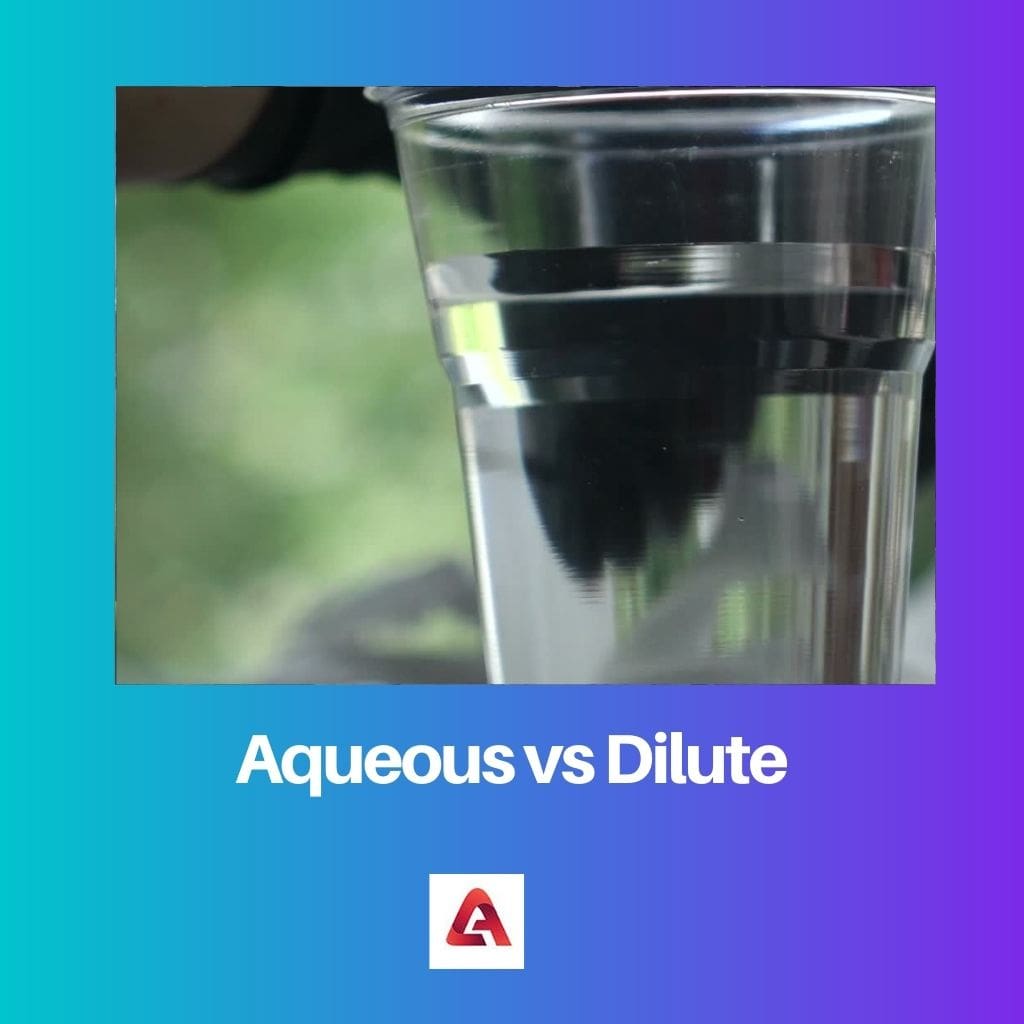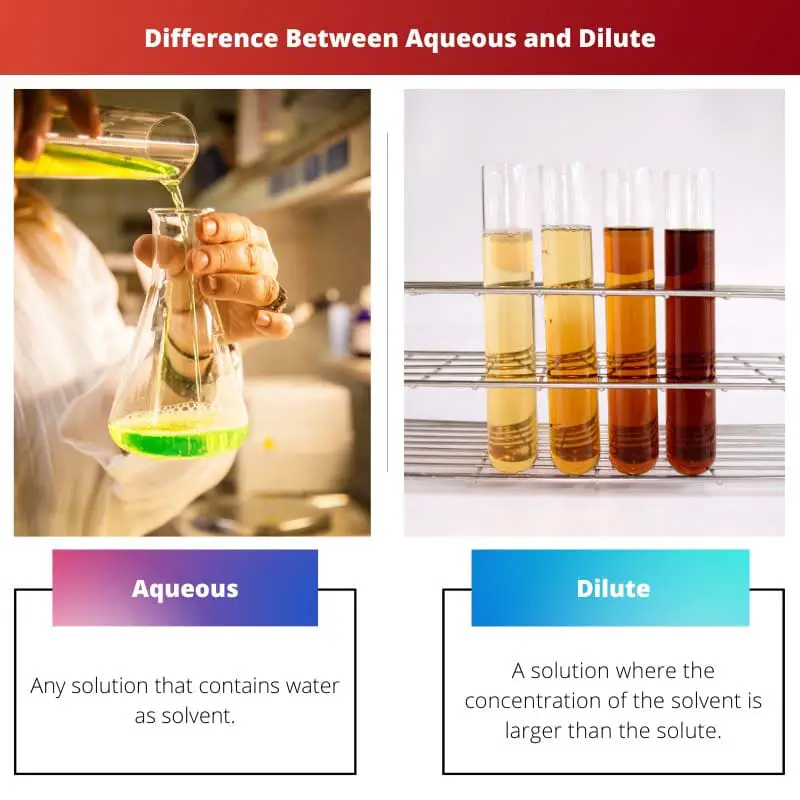A solution is a homogenous combination of two or more components with particles less than one nanometer in size. Chemistry lab workers must be familiar with the phrases aqueous and dilute.
Because they lack quantitative precision, the words aqueous and dilute solution are ambiguous.
Aqueous solutions feature water as the solvent, whereas dilute solutions contain a little quantity of solute or have a low lower solute concentration in comparison to the solvent.
Key Takeaways
- Aqueous solutions contain a substance dissolved in water as the solvent.
- Dilute solutions have a relatively low concentration of solute compared to the solvent.
- An aqueous solution can be dilute, but not all dilute solutions are necessarily aqueous.
Aqueous vs Dilute
The difference between aqueous and dilute is that an aqueous solution is a solution in which the solvent is water. Aqueous solution means anything mixed with water. You can make an aqueous solution of metal nanoparticles. On the other hand, a dilute solution is a solution in which the concentration of the solvent is larger than the solute. Dilute, is used to refer to chemicals in rather a sophisticated way of saying intentionally contaminated for applications in some places.

Aqueous is a term derived from the Greek aqua, it refers to something that is linked to, comparable to, or dissolved in water.
Water is a common solvent in chemistry because it is an excellent solvent that is also naturally abundant. An aqueous solution is a water with a pH of 7.0 and an Arrhenius balance of hydrogen ions (H+) and hydroxide ions (OH).
A dilute solution has a low concentration of solute compared to the solvent. A concentrated solution, which has high quantities of solute in the combination, is the polar opposite of a dilute solution.
To generate a dilute solution, simply introduce a new solvent without incorporating any more solute into the original sample.
Comparison Table
| Parameters of Comparison | Aqueous | Dilute |
|---|---|---|
| Definition | Any solution that contains water as solvent | A solution where the concentration of the solvent is larger than the solute. |
| Process | Adding any solute to water to make a solution | Adding water or any other liquid to dilute a concentrated solution. |
| Concentration | Can be concentrated or diluted | Cannot be concentrated |
| Solvent | Only water | Any substance |
| Examples | Aqueous ammonia, an aqueous solution of sodium chloride, etc. | Rainwater, adding water to concentrated juice, etc. |
What is Aqueous?
Any solution using water as the solvent is referred to as an aqueous solution. To dissolve in water and form an aqueous solution, the solutes must be hydrophilic and polar.
Even though water is known as the universal solvent, it cannot dissolve almost anything. Because fat cannot be dissolved in water, there are no aqueous fat solutions available.
To indicate that a substance is in an aqueous solution, we use the symbol (aq) as a subscript in a chemical equation.
We call an aqueous solution conductive if the solute may dissociate into ions when it dissolves in water and conducts electricity through the solution due to the presence of ions.
An aqueous solution is one in which water serves as the solvent. Appending (aq) to the applicable chemical formula is the most common way to show it in chemical equations.
A solution of table salt, or sodium chloride (NaCl), in water, is expressed as Na+(aq) + Cl, for example (aq).
Metathesis reactions are the most common type of reaction in aqueous fluids. Double-displacement reactions, in which a cation displaces to create an ionic connection with the other anion, are known as metathesis reactions.
The cation that was previously bound to the latter anion will dissociate and re-bond with the other anion.
Strong electrolytes are found in aqueous solutions that transmit electric current well, whereas weak electrolytes are found in those that do not.
Strong electrolytes are chemicals that are entirely ionized in water, whereas weak electrolytes only have a minor degree of ionization.
When a material dissolves in water, the abbreviation (aq) is added to its chemical name. Many ionic chemicals and hydrophilic (water-loving) entities dissolve in water.
Conducting electricity is frequently possible in aqueous solutions. Seawater, for example, is a good electrical conductor because it contains powerful electrolytes.
Double replacement reactions are common when chemical reactions occur between species in an aqueous solution. Aqueous solutions cannot be made by mixing sand and water.

What is Dilute?
A dilute solution has a low solute concentration, which is much lower than the solute’s solubility. A weak solution of dissolved salt from a well in drinking water.
The solution of known concentration can be further lowered and diluted by adding distilled water. To produce a dilute solution, just add additional solvent without adding any more solute to the original mixture.
The solution is then vigorously mixed to combine the two components. This guarantees that the composition of all portions of the combination is the same.
Diluting chemicals include gases, vapors, and liquids. Solutions are mixed and can be regulated to achieve the appropriate concentration level.
The concept of a dilute solution differs from that of a concentrated solution. All of the solutes in dilute solutions are undersaturated. That is, the solute concentrations in a dilute solution are much fewer than their solubilities.
It is vital to remember that defining whether a solution is dilute or concentrated is dependent on the solubility of its solutes. At 20 degrees Celsius, potassium hydroxide (KOH) is soluble in 1,120 grams per liter of solution.
A dilute potassium hydroxide solution would have a solute concentration substantially lower than 1,120 grams per liter.
A dilute solution would be created by dissolving 340 grams of potassium hydroxide in a liter of water, for example.
Unless we were working with a solute with a lower solubility, however, introducing 340 grams of solute may result in a concentrated solution. For example, the salt potassium chloride (KCl) has a solubility of roughly 340 grams per liter.
So, 340 grams of KCl in one liter of water results in a concentrated solution, whereas 340 grams of KOH in one liter of water results in a dilute solution.
The essential issue here is that the use of the phrases dilutes, or concentrates is always dependent on the solute’s solubility. The process of dilution can be used to transform a concentrated solution into a dilute solution.
This entails simply adding more solvent to the solution until the solute concentration is significantly lower than it was in the concentrated beginning solution.

Main Differences Between Aqueous and Dilute
- An aqueous solution is one in which the solvent is water, whereas a dilute solution is one in which the solvent concentration is greater than the solute concentration.
- Process for an aqueous solution is by mixing any solute with water, whereas process to making a dilute solution by diluting a concentrated solution with water or any other liquid.
- Aqueous solutions can either be concentrated or diluted. A dilute solution, on the other hand, maybe concentrated.
- An aqueous solution is any solution that uses water as the solvent. While a dilute solution is made up of any material that includes water as a solvent.
- Aqueous ammonia, the aqueous solution of sodium chloride, etc. are some of the examples for aqueous meanwhile rainwater, adding water to concentrated juice, etc. are some of the examples of dilute solution.

